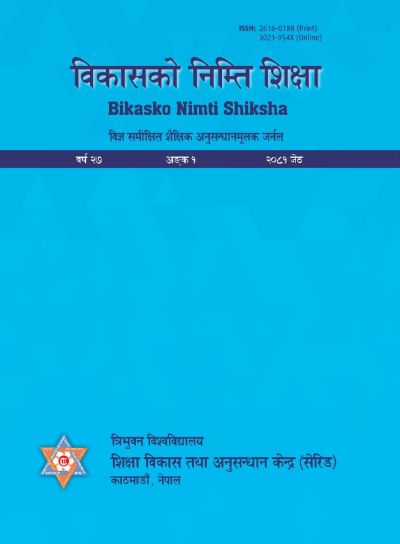अन्तःकरण चतुष्टय : अवधारणात्मक बुझाइ र मनोशैक्षिक झलक {Antahkarana Chatushtaya (The Four Innermost Instruments): Conceptual Understanding and Psycho-Educational Glimpse}
DOI:
https://doi.org/10.3126/bns.v27i1.66410Keywords:
अन्त:करण चतुष्ठय antakhakarana chatushtaya, अन्तरङ्ग साधन antaranga sadhana, बहिरङ्ग साधन bahiranga sadhana, मनोशैक्षिक विश्लेषण psycho-educational analysis, वेदान्त vedantaAbstract
वेदान्त दर्शनअन्तर्गत ‘अन्तःकरण चतुष्टय’ को विषयमा विस्तृत चर्चा पाइन्छ । यो विषय शैक्षिक तथा शिक्षा मनोवैज्ञानिक दृष्टिले महत्त्वपूर्ण छ । दर्शनशास्त्र तथा शिक्षाशास्त्रमा चासो राख्ने प्राज्ञहरू तथा विद्यार्थीहरूले यस विषयमा परिचित हुन आवश्यक भएकाले उक्त अवधारणाको बोध गर्ने र त्यसलाई मनोशैक्षिक दृष्टिले व्याख्या गर्ने ध्येयले यो लेख तयार गरिएको हो । यसमा हर्मेन्युटिक्स र नौचरणीय अध्ययन विधिहरूको अवलम्बन गरी शास्त्रमा उल्लिखित विषयवस्तुको व्याख्या गरिएको छ । वेदान्तका अनुसार मन, बुद्धि, चित्त र अहङ्कारको संयुक्त नाम अन्तःकरण चतुष्टय हो । यसले मानिसलाई कर्ममा उत्प्रेरित गर्छ । त्यसैले अन्तःकरण चतुष्टयलाई भित्री औजार पनि भनिन्छ । मनले सङ्कल्प र विकल्प गर्छ । मनभन्दा माथिल्लो सत्ता बुद्धि हो । यसले मनबाट प्राप्त सूचनाहरूको विवेकपूर्ण विश्लेषण गरी निर्णयको तहमा पुर्याउँछ । बुद्धिभन्दा उच्च सत्ता चित्त हो । चित्तले यो जन्म र पूर्वजन्मका स्मृति एवम् संस्कारहरू बोकेको हुन्छ । तिनैले बुद्धिको निर्णय प्रव्रिmयामा प्रभाव पार्छन् । अहङ्कार अन्तःकरणको उच्चतम सत्ता हो । यो ‘अहम्’ वा ‘म’ भन्ने सत्ताको बोध वा पहिचान हो । अहङ्कारकै कारण मन, बुद्धि, चित्त र इन्द्रिय तथा कर्मेन्द्रियहरू क्रियाशील हुन्छन् । व्यक्तिले गर्ने कर्म तथा वासनाका कारण मन, बुद्धि, चित्त र अहङ्कार दूषित भएका हुन्छन् । दूषित अन्तकरणले मानिसलाई अधोगतितर्फ प्रेरित गर्दछ । अन्तःकरण शुद्धिका लागि वेदान्तले बहिरङ्ग साधन विवेक, वैराग्य, षट्सम्पत्ति र मुमुक्षाको सिफारिस गरेको पाइन्छ भने अन्तरङ्ग साधन श्रवण, मनन र निदिध्यासनको अभ्यास गर्न सुझाइएको छ । वेदान्त दर्शनमा पनि उपयोगी शिक्षण विधिहरू तथा शिक्षा मनोविज्ञानसँग सम्बन्धित विचारहरू छन् भन्ने तथ्य यस लेखले उजागर गरेको छ । प्राज्ञ तथा प्राज्ञिक निकायहरूले यस्ता शास्त्रहरूको अध्ययन अनुसन्धानमा विशेष ध्यान दिनु आवश्यक छ ।
{While studying the philosophy of Vedanta, we found that there was a detailed discussion on the topic of "Antahkarana Chatushtaya" (the four innermost instruments). It is our understanding that the subject is important from the educational and psychological point of view. This article has been prepared with the aim of understanding the concept and explaining it from a psycho-educational point of view, as scholars and students who are interested in philosophy and pedagogy need to be familiar with this subject. In it, the subject mentioned in the scriptures is explained by adopting hermeneutics and nine-step rendition methods. According to Vedanta, the combined name of Mana (mind), Buddhi (intellect), Chitta (consciousness) and Ahankara (ego) is Antahkarana Chatushtaya. It motivates people to action. That's why Antahkarana Chatushtaya is also called inner tool. The mind makes decisions and choices/alternatives. Higher existence than mind is intellect. It leads to the level of decision by judicious analysis of the information received from the mind. Higher existence than intellect is the consciousness. The consciousness carries the memories and traits of this birth and previous births. They influence the decision-making process of the intellect. Ego is the highest power of Antahkarana. It is the realization or identification of the entity called 'Aham' or 'I'. It is because of the ego that the mind, intellect, consciousness, senses and sense organs are active. The mind, intellect, consciousness and ego are polluted due to the actions and desires of a person. An evil Antahkarana drives human beings towards degradation. Vedanta recommends the external means of Vivek (wisdom), Vairagya (absence of worldly desire), Shatsampatti (six instruments) and Mumuksha (aspiration of salvation) to purify the Antahkarana while the internal means of Shravana (listening), Manana (reflecting) and Nididhyasana (deeper meditation) are recommended. This article has revealed the fact that Vedanta philosophy also has useful teaching methods and ideas related to educational psychology. It seems that scholars and academia should pay special attention to the study and research of such scriptures.}
Downloads
Downloads
Published
How to Cite
Issue
Section
License
Copyright (c) 2024 Author

This work is licensed under a Creative Commons Attribution-NonCommercial 4.0 International License.




